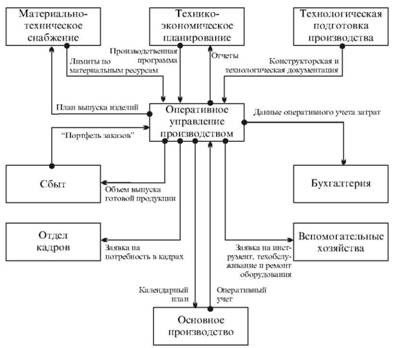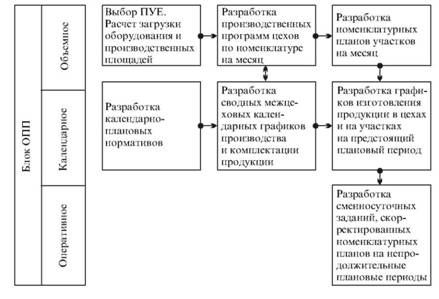home
 Management Management
 Organization of production - Kurochkin A.S. Organization of production - Kurochkin A.S.
|
Organization of production - Kurochkin A.S.
6.2. Operational and production planning is the central part of the organization of rhythmic work
System of operational management of production
In the management of modern enterprises, the system of operational control of production (PMO) is distinguished on the basis of the unity of tasks of operatively ensuring the rhythm of the production process with rational use of resources.
The PMO system, like any other, is characterized by the goal, the criteria for achieving it, the functions that ensure a purposeful activity, the structure, that is, the composition of the elements and their interaction during the management of the production process. The main task of this system is to ensure the rhythm of the production process in the shops, in the plots and in the workplaces. The ultimate goal of the PMU in accordance with the company's system of objectives is to ensure the fulfillment of the plan for the production, sale and delivery of products in accordance with specified volumes, nomenclature and quality in a timely manner, with rational use of material and labor resources, as well as production potential in general.
The shortcomings in the organization of production, its rhythm can only be partially compensated by efforts in the field of operational management, but even the most perfect structure of the PMU is not able to ensure the fulfillment of the set goals and tasks in the presence of serious defects in the controlled process.
The system of operational control of production plays the role of the main receiver and source of information for all basic services of the enterprise. In Fig. 39 is a flow diagram of information flows, the source and consumer of which is the GPR system.

Fig. 39. The enlarged scheme of information flows between PMO and other services of the enterprise
In the operational management system, several basic elements are traditionally distinguished: planning, accounting, control, analysis and regulation. The last four elements are often combined into the dispatch function (Figure 40).

Fig. 40. Functional structure of the operational management system of production
Operational and production planning: the essence and tasks
The central link of the PMO system is the operational and production planning (OPP). In the modern theory of the organization, confirmed by the practice of advanced enterprises, the system of the OPP is considered as a multi-level system, structured into blocks and stages of planned works. There are three levels of operational planning:
• factory (inter shop);
• Workshop;
• Precinct.
By the nature of the methods used, the planned works are divided into three successively executed blocks: volumetric, calendar and operational (current) planning.
The main task of volume planning is the distribution of the volume of work performed by departments and planning periods, taking into account the load of equipment and areas. As a rule, the planning period is a year.
Scheduling involves determining the timing of the beginning and end of work in the shops, the timing of their products to other shops, if necessary, adjusting the results of volumetric calculations. In calendar calculations, the planned period is usually the month or quarter.
The task of operational planning is to develop specific production assignments for the nomenclature of works and performers for short planning periods (ten days, a week, five days, a day, a working shift, an hour).
In the order of priority, the work on the OPP is divided into stages: preliminary calculations and development of plans. At the intersection of structural generatrices an integral system of operational production planning is formed (Figure 41). It covers the following basic elements of such a system:
• selection and justification of the planning and accounting units (PUE);
• Calculation of the loading of equipment and production areas;
• development of calendar-planned standards (CIT);
• development of shop and in-shop programs (volumetric calculations);
• formation of inter-shop and intra-shop production schedules (calendar calculations);
• formation of operational (shift-daily, hourly, etc.) tasks.
Scheduled accounting units
The choice of planning and accounting units consists in the expedient consolidation or, conversely, the specification of the range of the production program for each level of operational planning and management - from larger units at the general factory level (order, machine kit, group set) to smaller ones at the shop level, Section (detail, operation).
| Stages and levels of OPP | ||
Preliminary calculations |
Development of plans |
|
Inter-shop planning |
In-house planning |
|

Fig. 41. Composition of elements of operational production planning
The value of volume calculations in operational planning is to determine the capabilities of equipment, areas, labor collectives to perform production tasks in the planning period, taking into account the speed of production, which is determined in the block of scheduling. However, volumetric calculations conducted without a calendar justification of the production process are only preliminary and can not replace or compensate for the lack of scheduling.
Calendar-planned standards (CIT)
The essence of the establishment of calendar-planned standards (batches of products, the duration of production cycles, advances, backlogs, etc.) consists in the normalization of the discrete manufacturing process in time. Contrary to the existing opinion of the CPS, even if they are not documented and not controlled, operate in any production as average characteristics of the organization of the production process in time.
The content of the scheduling consists in determining, on the basis of the CIT, the timeframe for performing production tasks for the planning period in the context of the established planning and accounting units, while observing the volume loading of the units.
An indispensable condition for the effective functioning of the operational production planning system, which allows to organize a coherent, conjugate and rhythmic work of all units of the enterprise, is the existence of a well-founded regulatory framework, which includes, in particular:
• calendar-planned standards - the duration of the production cycle, the size of the lot and the amount of advance, the frequency of launching production, the size of the stockpile, etc .;
• standards of material consumption - the consumption of raw materials, semi-finished products and materials per unit of output;
• rates of use of production capacities - equipment performance, coefficient of shifts;
• standards of material security of production - the norms of technological, intra-shop and interchain consignments, the norms of stocks of raw materials, semi-finished products,
Efficiency of operational and production planning
The criteria for assessing the effectiveness of the OPP include:
• rhythmic work of production sites, workshops and enterprises as a whole and uniform output;
• The level of use of the means of production - equipment, production areas, facilities, units and labor;
• minimum duration of the production cycle;
• Minimal stocks of work in progress.
The well-considered and qualitative fulfillment of the basic tasks of operational planning improves almost all the basic indicators of production (Table 22).
Table 22
PRODUCTION-ECONOMIC IMPORTANCE OF OPERATIONAL PLANNING
| The main tasks of operational planning | Economic results achieved through the rational solution of operational planning problems |
Execution of tasks for the production of finished products |
The most complete provision of consumers. Reduction of inter-factory stocks and acceleration of the turnover of funds in the national economy. Reducing the cost of production due to conditionally fixed costs |
Organization of rhythmic and complete production process |
Reduction of the size of the work in progress in connection with the complete course of the process. Decrease in the level of required inter-plant stock of production. Elimination of downtime of equipment and increased use of production capacity. Eliminate the downtime of the workforce in some periods of time and overtime in others. Reduction of unproductive costs associated with the wrong overall production regime. Reduction of rejects in production |
Ensuring a densified loading of equipment and labor |
Increasing the efficiency of the use of fixed assets. Elimination of downtime of workers in connection with poor preparation of production and inconsistency of certain related processes. Reducing the cost of production by eliminating conditionally fixed expenses and paying for downtime |


Comments
When commenting on, remember that the content and tone of your message can hurt the feelings of real people, show respect and tolerance to your interlocutors even if you do not share their opinion, your behavior in the conditions of freedom of expression and anonymity provided by the Internet, changes Not only virtual, but also the real world. All comments are hidden from the index, spam is controlled.